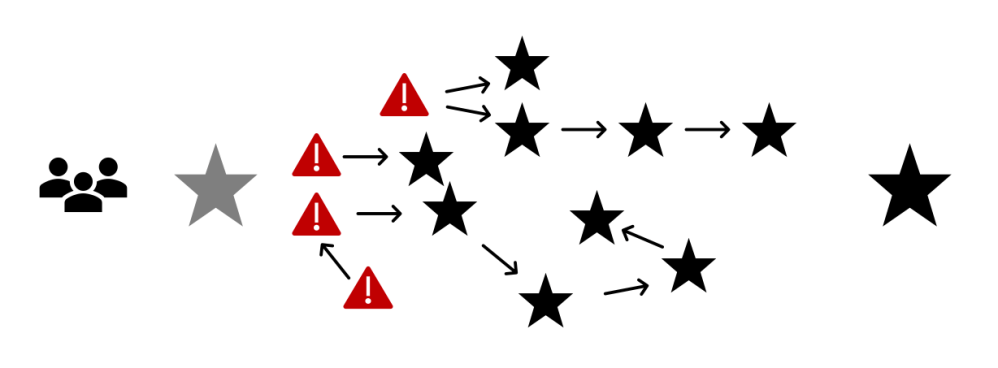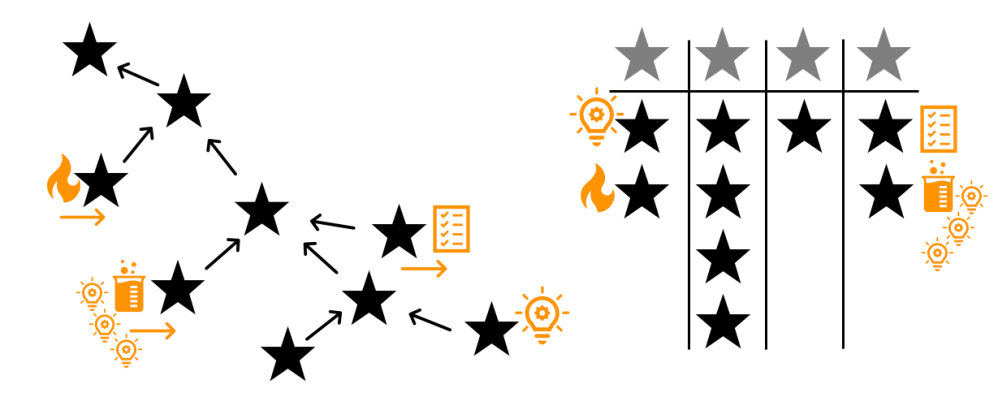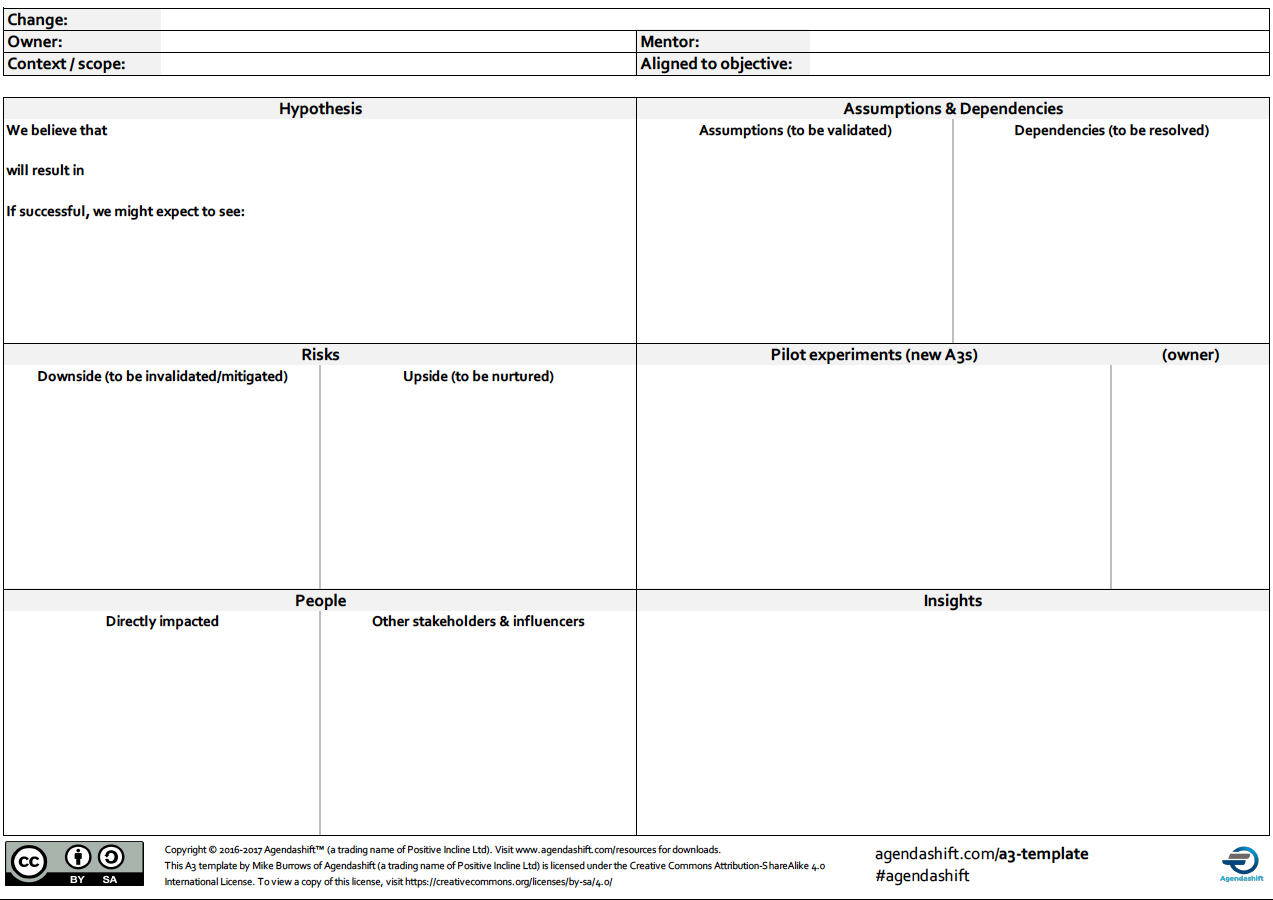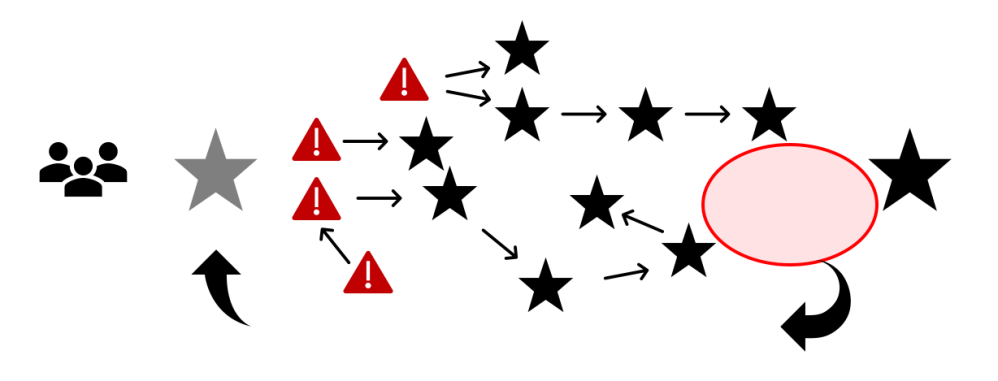First, what doesn’t work (or at least it fails more often than it succeeds), transformation (Agile or otherwise) as project:

Using a shallow and dysfunctional version of a model that was already tired 20 years ago [1], linear plan meets adaptive challenge in a complex environment. Seriously? I’m not sure which is the saddest thing – that its failure modes are so painfully familiar, or that they’re so avoidable:
- Instead of obsessing over how to overcome resistance, stop provoking it! Instead of imposing change, make it a process that is open in a big way to meaningful participation and creative collaboration.
- Wrong solutions aren’t a problem if your experiments are:
- small enough to fail quickly, cheaply, and safely
- framed to generate learning about real needs, succeed or fail
- Instead of being driven by solutions – with energy wasted on the consequences of commitments made in the past – organise around outcomes, getting quickly to the point where you can confirm that they are already beginning to be realised
- Instead of a depressing sequence of failed change projects – each of which on its own would risk fatigue – normalise a continuous style of change, baking it into everyday ways of working
None of this is hard. Despite its record of failure though, that linear model has familiarity on its side, not to mention generations of managers being taught that this how things are done “properly”. Thankfully, credible alternatives do exist however (see [2] for a selection), and here’s Agendashift (this is the Agendashift blog after all).
Agendashift’s defining characteristic is that it is outcome-oriented. Just about every part of it deals in some way with outcomes: identifying them, articulating them, organising them, working out how they might be achieved, and on on. In this post I endeavour to visualise that process.
I will describe Agendashift in 10 steps. That might sound worryingly linear, but there’s some structure to it:
- Steps 1-4 are happening frequently, at different levels of detail, and to varying degrees of formality – in fact those are just some of the ways in which Agendashift scales (the topic of a forthcoming post). Together, these steps represent a coaching pattern (or routine, or kata if you like). It’s not just for practitioners – we teach it to participants too, introducing a more outcome-oriented kind of conversation into organisations that may have become over-reliant on solution-driven conversations.
- Steps 5-9 are about managing options, a continuous process punctuated from time to time by more intense periods of activity.
- Step 10 could just as easily be numbered step 0 – it’s about the organisational infrastructure necessary to sustain the transformation process.
Steps 1-4: A coaching pattern that anyone can practice
Step 1: Bring the challenge close to home
The pattern starts with some kind of generative image, the organisation development (OD) community’s term for “ideas, phrases, objects, pictures, manifestos, stories, or new words” that are both compelling in themselves and are capable of generating a diverse range of positive responses [3, 4].
Agendashift provides a number of these starting points:
- The Agendashift True North [5]
- The prompts of one of the Agendashift assessments; the Agendashift delivery assessment in particular has 43 of these, a few of which are prioritised by people individually or in small groups
- Potentially, any of the outcomes generated through this process overall (we make this explicit in the Full Circle exercise, presented in the book [6] as an epilogue)
Sometimes these generative images may seem out of reach, but nevertheless, reflecting on them is typically a positive experience, sometimes even cathartic. The invitation is simple:
- “What’s that like? How is it different to what you have now?”
- “What’s happening when this is working at its best for you?”
- “X months down the line, what will you be celebrating?”

Step 2: Identify obstacles
Again, a simple question:
- “What obstacles are in the way?”

Step 3 (optional): Clarify
Deep diagnosis at this stage tends not to be productive. Sometimes however it can be helpful to clarify a little, when obstacles seem vague and/or overgeneralised, or when they seem to prescribe a solution already:
- “What kind of X?” (the X here referring to an obstacle)
- “What’s happening when X?” (ditto, this question being helpful for finding the real obstacles that motivate prematurely-specified solutions)

Step 4: Outcomes, more outcomes, and yet more outcomes
From our generative image, a generative process, one capable of producing lots of output! It starts with a classic coaching question:
- “What would you like to have happen?” (for an obstacle)

Moving deeper into ‘outcome space’:
- “And when X, then what happens?” (the X here identifying an outcome noted previously)

Clarifying, exploring locally, or preparing to take conversation in different direction:
- “What kind of X?”
- “What is happening when X?”

See [7] for more of these Clean Language questions (with a video) and [8] for an brief introduction to how they work. What we have here is a highly repeatable coaching pattern adaptable to a wide range of contexts. And as we practice it we’re teaching change agents of every kind how to speak the language of outcomes.
Steps 5-9: Managing options
These steps are about managing the bigger picture (sometimes quite literally):
Step 5: Organise (Map)
Here are two possible visual organisations of the generated outcomes: the Options Orientation Map (aka Reverse Wardley [9,10]) and something akin to a User Story Map, with outcomes prioritised in columns:

Step 6: Prioritise, just in time
When – by design – everything is changing, it’s better to give yourself options than to decide and specify everything up front:

Step 7: Choose the right kind of approach
Outcomes don’t just vary by size or difficulty, they differ fundamentally:
- Outcomes that need the minimum of ceremony, because everyone can easily agree what needs to be done
- Outcomes that can be delegated to someone with the necessary expertise
- Outcomes for which multiple ways forward can be identified, yet (paradoxically perhaps) it’s clear that the journey will involve twists and turns that are hard to predict
- Outcomes for which it’s hard to see beyond symptomatic fixes
If you’re thinking Cynefin at this point, well spotted! See [9, 10] again.

Step 8: Generate options
Where you want innovation, create the opportunity to generate multiple options for the outcome or outcomes currently under the spotlight, and as diverse as you can make them. If you have a framework in mind and it has good options for your current challenges, include them! (We’re framework-agnostic, not anti-framework!)

Step 9: Frame hypotheses, develop experiments
Not every outcome is best approached this way (see step 7), but where uncertainty is high, frame your chosen option as a hypothesis, then develop it as an experiment [11]:

Keeping the show on the road
Step 10: Rinse and repeat
So often said, and so often ignored! Whenever you hear “change cycle” or “improvement cycle”, it’s important to ask about the mechanisms in your organisation design (structure, process, leadership behaviours, etc) that will sustain the process. That’s a question we know to ask, and we have some helpful patterns to suggest when the current organisation design is lacking.
Among other things, we’re looking for at least three levels of feedback loop:
- The day-to-day meetings whose purpose is to help people make informed choices about what to do, where to collaborate, and when to seek help
- Operational review meetings that:
- Step far enough back from the day-to-day to scrutinise progress (or lack thereof) in terms of both speed and direction
- Create expectations of continuous and impactful experimentation
- Cause learnings to be aired and spread
- Strategic review meetings that reconfirm key objectives (calibrating the level of ambition appropriately), and ensure the right levels of commitment relative to other goals
One way to visualise the strategic calibration part is as an “aspiration gap”, the area in red below between the outcomes being worked towards and the overall challenge that seeded this process.

Sometimes the aspiration gap is so big that it isn’t even recognised – not seeing the wood for the trees, so to speak. With too little ambition and too little coherence across the options under consideration, both energy and alignment are lacking. Continuous improvement initiatives are prone to this; their failure modes may be different from those of the linear change project but failure here is still uncomfortably common.
Conversely, when the aspiration gap is small, there may be too much focus on an overly specific objective, leaving few options available outside a prescribed path. You’re into linear planning territory again, and we know how that goes!
This is why those three feedback loops are so necessary. Almost by definition, continuous transformation needs daily conversations. For it to be sustained, it also needs a tangible sense of progress and periodic reorientation and recalibration.
“Outcome-oriented change and continuous transformation” – the strapline to the Agendashift book – summarises the process pretty well. If there’s anything hard about it, it is simply that it’s a departure from that familiar but tired old linear model, the one that we all know doesn’t really work. So dare to try something new!
References
[1] What kind of Organisational Development (OD)? (And a book recommendation)
[2] Engagement: more than a two-way street
[3] Notes on Dialogic Organizational Development (medium.com)
[4] Gervase Bushe: Generative Images (youtube.com)
[5] Resources: True North
[6] Agendashift: Outcome-oriented change and continuous transformation
[7] 15-minute FOTO
[8] My favourite Clean Language question
[9] Stringing it together with Reverse Wardley
[10] Takeaways from Boston and Berlin
[11] The Agendashift A3 template
What if we put agreement on outcomes ahead of solutions?
Agendashift™: Serving the transforming organisation
Agendashift Academy: Leading with Outcomes | Home | Store
Links: Home | Subscribe | Become an Agendashift partner | Events | Contact | Mike
Resources: Tools & Materials | Media | Books | Assessments
Blog: Monthly roundups | Classic posts
Community: Slack | LinkedIn group | Twitter
